PARIS, May 29 (UPI) -- A European satellite launched in 2010 to measure sea-ice thickness in the arctic is also yielding high-resolution mapping of the ocean floor, scientists say.
While the main objective of the polar-orbiting CryoSat is to measure the thickness of polar sea ice and ice sheets that blanket Greenland and Antarctica, its radar altimeter can also measure tiny changes in sea level, the European Space Agency reported Monday.















